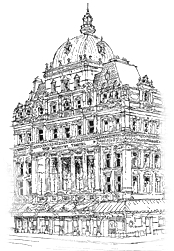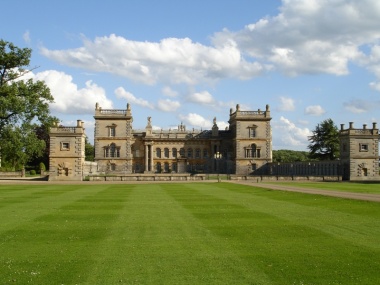
 | The Gallini Family Tree |
| Home | Contact | Statistics | Index |
Grimsthorpe Castle, Bourne, Lincolnshire
 |
Grimsthorpe Castle. The history can of the Castle be found in the castellated mediaeval tower that dates to an era when the de Gaunt family held the Earldom of Lincoln. Gilbert de Gant, the great grandson of Baudouin, Count of Flanders, had succeeded in 1192 as 5th Lord of Folkingham. Created Earl of Lincoln in 1216 by Prince Louis of France (later Louis VIII), he was dispatched to the north to oppose King John during the baron's revolt. He devastated the city of Lincoln but was later taken prisoner and deprived of his estates. He died in 1242. Much of his large estate eventually passed to Henry, 1st Lord Beaumont, who served both Edward I and Edward II in a military capacity. Lord Beaumont's ancestry is uncertain, but two of his children made excellent marriages. Isabel became the wife of Henry the good Duke of Grosemont, father of John of Gaunt; his eldest son, John, married Eleanor Plantagenet, great granddaughter of Henry III. Whatever her parentage, Maria de la Salinas came to England in 1503 to replace her cousin, Maria de Rojas, as one of Catherine of Aragon's ladies and by 1514 was considered to be Queen Catherine's closest friend. She was naturalized in 1516, shortly before her June 5th marriage to William, 11th Baron Willoughby de Eresby (d.1526), master of the royal hart hounds. They were given the loan of Greenwich Palace for their honeymoon and the manor of Grimsthorpe, Lincolnshire as a wedding present by Henry VIII. The association with Grimsthorpe and the Barons Willoughby de Eresby, which has lasted down the centuries began when Henry, 5th Lord Beaumont married Elizabeth Willoughby, daughter of William, 5th Baron de Eresby. Their grandson, William was the last of the Beaumont family line. His second wife, Elizabeth Scrope, previously married to the Earl of Oxford, occupied Grimsthorpe until her death in the summer of 1537. In March 1520 Maria gave birth to a daughter, Katherine, and the Tudor additions at Grimsthorpe that hide much of the medieval building occurred during her lifetime. Dating back to 1313, the Barony of Willoughby de Eresby is one of the few English peerages which can pass in the female line. Katherine was only about six when her father died and she succeeded as 11th Baroness and heiress to Grimsthorpe. She became a ward of the king until 1528 when Henry VIII sold the wardship to his brother-in-law, Charles Brandon, Duke of Suffolk. Suffolk's devious plan was for his young son, Henry Brandon, Earl of Lincoln, to improve his prospects by marriage to Katherine but the scheme collapsed in 1533 when his wife, Mary Tudor, Dowager Queen of France, died and their son Henry became terminally ill. Ever the opportunist, Suffolk, then aged about 50, took the fourteen-year-old Lady Katherine for his fourth wife. Within two years riots occurred in Lincolnshire inspired by the King's policy to dissolve the monasteries. This led to the Pilgrimage of Grace when many northern lords gave their support to the abbots and monks who were being ejected from their religious houses. Henry VIII ordered Suffolk to Lincolnshire to help crush the revolt. With the dissolution of the Abbey of Vaudey, which stood in the grounds of Grimsthorpe, Suffolk had an excellent supply of stone available to improve and enlarge his wife's inheritance and make it ready for a visit by the King, who planned to stay there while on his way to meet his nephew, James V of Scotland, in York. Seemingly the additions were hastily constructed as substantial repairs had to be carried out later due to the poor state of the foundations. In 1545 Katherine became a widow at the age twenty-six upon the death of Charles Brandon, Duke of Suffolk. Some six years later both her sons died of sweating sickness on the same day. It was rumoured in 1546 that Henry VIII had expressed his interest in marrying Katherine but later she rejected the offer of marriage from Zygmunt, King of Poland preferring Richard Bertie her gentleman usher. Katherine was a staunch Protestant which led to her imprisonment in the Tower of London during the reign of Queen Mary. To escape further persecution, the Catherine and her husband Richard Bertie sought refuge on the continent but they and their children were only able to return to Grimsthorpe with the accession of Elizabeth I, however by then the house was suffering from neglect. The fortunes of the family had improved by the time Robert Bertie, 13th Baron entertained James I and Anne of Denmark at Grimsthorpe in 1611. Through the fortunate marriage of his father he inherited the office of Lord Great Chamberlain. Further prestige came when he was created Earl of Lindsay by Charles I. During the Civil War the family firmly supported the Royalist cause. In October 1642 Lindsay was appointed General of the Royal Army. In that month two of his sons were killed at the Battle of Edge Hill, he was wounded and died shortly afterwards. Another son, Montague, was one of the peers who attended the burial of the King after his execution. By the time Britannia Illustrata was published in 1707, the 15th Baron Willoughby de Eresby and 3rd Earl Lindsay had rebuilt the north front of Grimsthorpe in the classical style. Presumably these improvements were not to the taste of the 17th Baron, who also held the title Duke of Ancaster and Kesteven, who employed Vanbrugh to replace the north front with a Baroque facade. Other ambitious plans to transform the rest of the building were modified after the Duke's death. Had all Vanbrugh's planned modifications been completed, it would not be possible to walk round Grimsthorpe today and see its past so clearly portrayed in its walls. What remains has been moulded and reshaped into a variety of styles that reflect changes in fashion and the fortunes of its owners. Now its future is in the hands of the Grimsthorpe and Drummond Castle Trust, a charitable body set up by the 3rd Earl of Ancestor and his daughter Jane Heathcote Drummond Willoughby, 27th Baroness Willoughby de Eresby. |